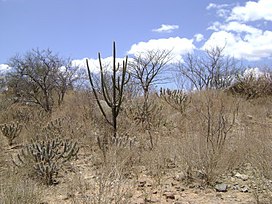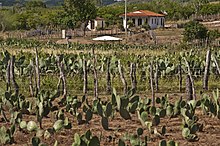Caatinga
6°00′00″S 40°00′00″W / 6.0000°S 40.0000°W
You can help expand this article with text translated from the corresponding article in Portuguese. (April 2014) Click [show] for important translation instructions.
|
| Caatinga | |
|---|---|
 Caatinga | |
 Map of the Caatinga ecoregion. | |
| Ecology | |
| Realm | Neotropical |
| Biome | deserts and xeric shrublands |
| Borders | |
| Geography | |
| Area | 730,850 km2 (282,180 sq mi) |
| Countries | Brazil |
| States | |
| Coordinates | 7°36′46″S 39°26′01″W / 7.612796°S 39.433699°W |
| Conservation | |
| Conservation status | Vulnerable |
| Protected | 44,133 km² (6%)[1] |
Caatinga (Portuguese pronunciation: [ka.ɐˈtʃĩɡɐ], locally [ka.aˈtĩɡɐ]) is a type of desert vegetation, and an ecoregion characterized by this vegetation in interior northeastern Brazil. The name "Caatinga" is a Tupi word meaning "white forest" or "white vegetation" (caa = forest, vegetation, tinga = white).
The Caatinga is a xeric shrubland and thorn forest, which consists primarily of small, thorny trees that shed their leaves seasonally. Cacti, thick-stemmed plants, thorny brush, and arid-adapted grasses make up the ground layer. Most vegetation experiences a brief burst of activity during the three-month long rainy season.
Caatinga falls entirely within earth's tropical zone and is one of 6 major ecoregions of Brazil. It covers 850,000 km², nearly 10% of Brazil's territory. It is home to 26 million people[2] and over 2000 species of plants, fish, reptiles, amphibians, birds, and mammals.
Geography
The Caatinga covers the interior portion of northeastern Brazil bordering the Atlantic seaboard (save for a fringe of Atlantic Forest), extending across eight states: Piauí, Ceará, Rio Grande do Norte, Paraíba, Pernambuco, Alagoas, Sergipe, Bahia, and parts of Minas Gerais. Altogether, the Caatinga comprises 850,000 km², about 10% of the surface area of Brazil.[3] By comparison, it is over nine times the surface area of Portugal, whence came Brazil's early European settlers, and 20% larger than the U.S. state of Texas.

Located between 3°S 45°W and 17°S 35°W, the Caatinga experiences irregular winds from all directions. Rainfall is thus intermittent but intense, totalling 20–80 cm (7.9–31.5 in) on average.[4] Although the climate is typically hot and semi-arid, the Caatinga includes several enclaves of humid tropical forest,[5] with trees 30–35 m (98–115 ft) tall.[4]

To the northwest, the Caatinga is bounded by the Maranhão Babaçu forests; to the west and southwest, the Atlantic dry forests and Cerrado savannas; to the east, the humid Atlantic coastal forests; and to the north and northeast, the Atlantic Ocean.
Climate
The Caatinga has only two distinguishable seasons: a hot and dry winter, and a cold and rainy summer. During the dry winter periods there is no foliage or undergrowth, as plants try to conserve water. Roots protrude through the surface of the stony soil, to absorb water before it is evaporated. Leaves fall off the trees to reduce transpiration.[4] With all the foliage and undergrowth dead during the drought periods and all the trees having no leaves the Caatinga has a yellow-grey, desert-like look. During the peak periods of drought the Caatinga's soil can reach temperatures of up to 60 °C.


The drought usually ends in December or January, when the rainy season starts. Immediately after the first rains, the grey, desert-like landscape starts to transform and becomes completely green within a few days. Small plants start growing in the now moist soil and trees grow back their leaves. Rivers that are mostly dry during the past 6 or 7 months start to fill up and streams begin to flow again.[5]

Ecology
Caatinga harbors a unique biota, with thousands of endemic species. Caatinga contains over 1,000 vascular plant species in addition to 187 bees, 240 fish species, 167 reptiles and amphibians, 516 birds, and 148 mammal species, with endemism levels varying from 9 percent in birds to 57 percent in fishes.[6]
Vegetation
The Caatinga does not correspond to a single type of vegetation, but rather a broad mosaic. Nonetheless, all vegetative structure is adapted to the xeric climate. Succulent and crassulaceous species dominate; non-succulents exhibit small, firm leaves and intense branching at the base, akin to shrubs. Palm stands usually contain carnaúba or babaçu palms, but occasionally tucumã and macaúba.
The Caatinga has enough endemic species to constitute a floristic province.

Most authors divide the Caatinga into two different subtypes: dry ("sertão") and humid ("agreste"), but categorizations vary to as many as eight different vegetative regimes.[4]

Fauna

The Caatinga is home to nearly 50 endemic species of birds, including Lear's macaw (Anodorhynchus leari), Spix's macaw (Cyanopsitta spixii),[Note 1] moustached woodcreeper (Xiphocolaptes falcirostris), Caatinga parakeet, Caatinga antwren, Sao Francisco black tyrant and Caatinga cacholote.[Note 2]
Endemic mammal species include:
- eleven rodents - Caatinga vesper mouse, Wiedomys pyrrhorhinos, Trinomys yonenagae, Trinomys albispinus minor, Trinomys albispinus sertonius, Thylamys karimii, Dasyprocta sp. n., Oryzomys sp. n., Oxymycterus sp. n., Rhipidomys sp. n. ssp. 1, and Rhipidomys sp. n. ssp. 2
- one primate - Callicebus barbarabrownae
- two bats - Xeronycteris vieirai and Chiroderma sp. n
Possible anthropogenic origins
Based on radiocarbon dating of potsherds, proponents of historical ecology such as William Denevan and William Balee have suggested that large sections of the Caatinga region may be of anthropogenic origin. Over 1000 years ago, native peoples may have unintentionally created the environment of the modern-day Caatinga through constant slash-and-burn agriculture, thereby stymying plant succession and preventing major rainforests from growing within the region.[7]
Conversely, fossil evidence suggests that the Caatinga may historically have been part of a much larger dry belt.[4][5]
Conservation
The Caatinga is poorly represented in the Brazilian Conservation Area network, with only 1% in Integral Protection Conservation Areas and 6% in Sustainable Use Conservation Areas.[6] Protected areas include Chapada Diamantina National Park, Serra da Capivara National Park, and Serra das Confusões National Park.
Economic developed has fragmented the native biome. Estimates on the amount of Caatinga transformed affected by economic development range 25-50%, making Caatinga the most degraded ecosystem in Brazil, following the Atlantic Forest, which has lost over 80% of its original cover.[5]
Economic exploitation

The local population lives in extreme poverty, and many rely on extraction of natural resources for a livelihood.[4][8] There are few drinkable water sources, and harvesting is difficult because of the irregular rainfall.
Agriculture
Native plants are used in local agriculture, much of it slash-and-burn.[5] Pilocarpus jaborandii appears to exhibit medicinal properties. The fruits of umbú and mangabá are used as food directly, and other species are used for forage. Local palms produce commercial-grade lauric and oleic oils, which undergirds much of the economy of northeast Brazil.[4]
Meliponiculture is also a well-developed and traditional activity in the region.[9] One of the most productive species, Melipona subnitida, known locally as jandaíra, produces up to 6 liters a year, resulting in economic profit for the population.[10]
Irrigation along the São Francisco River promises to turn the region into a breadbasket. The soil is very fertile, and existing irrigation infrastructure already supports the export of grapes, papayas and melons. At the same time, irrigation threatens to salinize the soil.[4]
Grazing
Cattle (Guzerá and Red Sindhi cattle) and goat farming are popular and very productive in the region.[11][12] Overgrazing and timbering for fuelwood have decimated local vegetative populations; outside irrigated regions, the area has begun to desertify à la Sahara and Sahel.
See also
On Caatinga
- Caatinga moist-forest enclaves
- Northeastern Brazil
- Sertão
- List of plants of Caatinga vegetation of Brazil
The five other major ecoregions of Brazil
Notes
- ^ Now extinct.[5]
- ^ There is no evidence, however, that the bird formerly known as Caatinga woodpecker occurs in Caatinga.
References
- ^ Eric Dinerstein, David Olson, et al. (2017). An Ecoregion-Based Approach to Protecting Half the Terrestrial Realm, BioScience, Volume 67, Issue 6, June 2017, Pages 534–545; Supplemental material 2 table S1b. [1]
- ^ Salcedo, I.H., Menezes, R.S.C. (2009): Agroecosystem functioning and management in semi-arid Northeastern Brazil, in: Tiessen, H., Stewart, J.W.B. (eds.): Applying Ecological Knowledge to Landuse Decisions. Inter-American Institute for Global Change Research - IICA-IAI-Scope, Paris, pp. 73–81.
- ^ "Mapa de Biomas e de Vegetação" [Biome and Vegetation Map]. Instituto Brasileiro de Geografia e Estatística (in Brazilian Portuguese). 21 May 2004. Retrieved 2019-02-22.
- ^ a b c d e f g h Lleras, Eduardo. "Caatinga of North-Eastern Brazil". Centres of Plant Diversity. Vol. 3: The Americas. Smithsonian Institution. Archived from the original on 3 March 2016.
- ^ a b c d e f Leal, Inara R.; Silva, José Maria Cardoso Da; Tabarelli, Marcelo; Lacher, Thomas E. (2005). "Changing the Course of Biodiversity Conservation in the Caatinga of Northeastern Brazil". Conservation Biology. 19 (3): 701–706. doi:10.1111/j.1523-1739.2005.00703.x. ISSN 1523-1739.
- ^ a b Santos, J.C.; Leal, I.R.; Almeida-Cortez, J.S.; Fernandes, G.W.; Tabarelli, M. (2011). "Caatinga: the scientific negligence experienced by a dry tropical forest". Tropical Conservation Science. 4 (3): 276–286. doi:10.1177/194008291100400306.
- ^ Balée, William (2013-08-20). Cultural Forests of the Amazon: A Historical Ecology of People and Their Landscapes. University of Alabama Press. p. 43. ISBN 9780817317867.
- ^ Untied, B. (2005). Bewässerungslandwirtschaft als Strategie zur kleinbäuerlichen Existenzsicherung in Nordost-Brasilien? - Handlunsspielräume von Kleinbauern am Mittellauf des São Francisco [Can Irrigation be a Strategy for Small Farmers' Economic Security in Northeast Brazil?: Economic milieu of small farmers in the central São Francisco valley] (in German). Marburg: Philipps-Universität Marburg.
- ^ Cortopassi-Laurino, Marilda; Imperatriz-Fonseca, Vera Lucia; Roubik, David Ward; Dollin, Anne; Heard, Tim; Aguilar, Ingrid; Venturieri, Giorgio C.; Eardley, Connal; Nogueira-Neto, Paulo (22 June 2006). "Global meliponiculture: challenges and opportunities". Apidologie. 37 (2): 275–292. doi:10.1051/apido:2006027.
- ^ Bonnatti, Vanessa; Luz Paulino Simões, Zilá; Franco, Fernando Faria; Tiago, Mauricio (3 January 2014). "Evidence of at least two evolutionary lineages in Melipona subnitida (Apidae, Meliponini) suggested by mtDNA variability and geometric morphometrics of forewings". Naturwissenschaften. 101 (1): 17–24. doi:10.1007/s00114-013-1123-5. PMID 24384774.
- ^ "Embrapa: Guzerá e sindi são alternativas para produzir leite no nordeste [do Brasil]". Milk Point (in Portuguese). Retrieved 10 January 2019.
- ^ "A importância da criação de caprinos e ovinos no nordeste [do Brasil]". Nordeste Rural (in Portuguese). Retrieved 10 January 2019.
Further reading
- Llosa, Mario Vargas - The War of the End of the World
Historical biogeographic surveys
- Marcgrav (1638)
- Spix & Martius (1817-1820)
External links
- "Caatinga". Terrestrial Ecoregions. World Wildlife Fund.
- IBAMA
- Brazil Nature
- Caatinga: Brazilian national heritage threatened
- Associação Mãe-da-lua The Avifauna of northeastern Brazil
